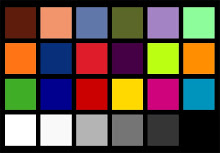
Do you have any idea what the above refers to? It's a brand spanking new
digital cinema workflow standard that is being developed by the Academy of Motion Picture Arts and Sciences (AMPAS). Called the
Image Interchange Framework (IIF) this is a complete specified architecture for placing any and all capture mediums into a standardized gamma and color space that far exceeds anything available today.
Here's the problem: you shoot film, RED, ALEXA, and 5D (dammit!) on your next 300-million dollar blockbuster (tentatively entitled "BANG!, silence, CASH!"). How do you handle viewing, conforming, grading, and outputting to different masters (ie: film print, digital master, blu-ray, HD broadcast, DVD, iPhone, etc.) all of this footage? Today most post houses have to handle all of these flavors uniquely in their own workflows. Film needs a LUT to display correctly on a facility's Baselight in order to mix it with the ALEXA footage. Then it needs an output LUT applied for a film-out and another different LUT applied for a rec709 output for broadcast. Everyone just loves the RAW files from the RED but those R3D's don't mean anything until they're debayered though REDCINE-X or some other proprietary software. The ALEXA footage could be ARRIRAW, ProRes Log-C Quicktimes, or uncompressed DPX frames. And the 5D... well let's just say it's gotta fit in too. Besides actually getting each capture medium to open up and play on a particular post system like DaVinci or Scratch the biggest concern is making sure what you're seeing on the screen is ALL or MOST of what each camera actually captured.
Here's a simple example: you want to grade and output a rec709 master of your film for television broadcast and you're dealing with ALEXA Log-C QTs. You've already calibrated your Baselight system to your new
Dolby 42" Display and have everything set into a rec709 gamma and color space. Good. Since this is where you want to end up it makes sense that this is where you should start, right? Hmmm, maybe not. Here's the problem, the ALEXA doesn't capture dynamic range and colors according to the rec709 specification (unless you set the camera to conform to this spec but who in their right mind would do that?). The ALEXA natively captures a much, much broader range of gamma and color gamut than is even allowed by the rec709 standard. This is indeed awesome because this is exactly how the camera is able to record such impressive dynamic range. What's important is that the camera captures as much information as possible so we can use all of it later in post during our final color-grading session and eventual conform/output. The distinction is in what parts of the whole we actually end up using. 13 stops of DR is great but usually looks like crap. Why? With all that tonal range you've inherently got LESS contrast. And as all self-conscious image makers know... contrast is your friend and should be embraced. Why does Log-C look so flat? Because it doesn't have any contrast! Duh...
Think of it as a box. Rec709 is a little box. Log-C is a much, much bigger box capable of storing a wide range of tones and colors. It's fine if you intend to finish within the rec709 space. The problem is stuffing that big Log-C box into the teeny, weeny rec709 box. If you simply just jam it in there you're liable to lose 50% of the ALEXA's color and tonal range. Eventually you'll HAVE to loose that range in order to finish your grade for TV broadcast but the distinction is if you can SEE all of the CAPTURED RANGE you can DECIDE what parts stay and what are discarded. This is the essence of color-grading. A nimble colorist will give you everything you need and none of what you don't. Unfortunately, just when a colorist feels confident in grading RED MX Build 1067.2 along comes some 500fps Phantom Flex footage. They may both be RAW files but they react to light and color in dramatically unique ways.
With film it was easy. DP's knew how film reacted to light and color. They knew how it needed to be processed and printed. And the colorist knew how to add points (printer lights) to create the DP's "look". The workflow and color science were well understood and standardized. Now, in our digital world, each camera behaves differently. Each camera
sees tonal range and colors different than the next. There is no standard as each camera
is it's own standard. The ALEXA has 13 stops of dynamic range. The RED has 13 stops of DR. Sony's F35 now has 13 stops of DR. And Kodak 5219 has 13 stops of DR. But each will map what it perceives as "blackest black" and "whitest white" to a different place on it's tonal curve. If I choose 5219's "black" as THE BLACK then the ALEXA, SONY, and RED would need to be somehow conformed to match how 5219 encodes BLACK. After that I'd have to calibrate 5219's BLACK to display correctly as "blackest black" on my new Dolby 42" display. Then make sure that the ALEXA, SONY, and RED matched that. And make sure that any other displays like my AC's 5" on-board monitor, my director's 17" monitor, my DIT's 24" master monitor, or my own living room's
103" Panasonic Plasma also match. Yeah, it's a pain. And most of the time they all match... sort of, kinda, close-but-not-quite, ok... no, not really, not even close.
So this is where the IIF comes in. The BIG IDEA here is to take any and all recorded sources and transform them into a standardized gamma and color space that is so large that it can hold all legacy and (hopefully) most future imaging devices (that would be cameras). By transforming a source (like ALEXA) through the AMPAS's Academy Color Encoding Specification (ACES) you can standardize and theoretically future-proof your entire capture-to-display workflow across every conceivable output (theatrical, tv, dvd, etc).
Again think of the IIF-ACES as a really, really, really BIG box that anything can fit into. Be it RED, Weisscam, Fuji Film, ALEXA, Sony F65, 5D, or yer iPhone everyone of these capture mediums will have it's own specified transform to take it from its native gamma and color space to the much larger and standardized IIF gamma and color space. Now you won't get anything for free here. If you shoot 8-bit with an AF-100 and encode it to the IIF's proposed 16-bit specification you're not gonna gain any extra DR or color gamut. You'll just have a lot of empty spaces between your little 8-bits. The obvious benefit is that once the transform is completed that "blackest black" will be consistent across all of your cameras, displays, and outputs. The RED's BLACK that encodes at .0023xr3d and the ALEXA's BLACK that encodes at 20c.-2 and the 5D's BLACK that encodes at "-crappy" and 5219's BLACK that renders at x,y slope will ALL be transformed to encode at simply 0 within the IIF.
So when your colorist pulls up the scene in your movie that has 5D inter-cut with film inter-cut with RED inter-cut with Phantom inter-cut with ALEXA... BLACK on ALL will appear BLACK on your display. And when you're finished with your final grade your Digital Master will appear the same across all of your deliverables (Theatrical, TV, Blu-Ray, You Tube, etc.). This is the hope and motivation at least. And I for one welcome it.
Though the IIF is still being refined FX's show
"Justified" is already using the standard as a basis for the show's pre-thru-post workflow. Check out
this HD Video Pro article on real-world implementation. If you want to implement IIF in your real world all that's needed is to
sign up. And if you're feeling especially nerdy and a glutton for punishment
REDUSER never fails to deliver the goods.






